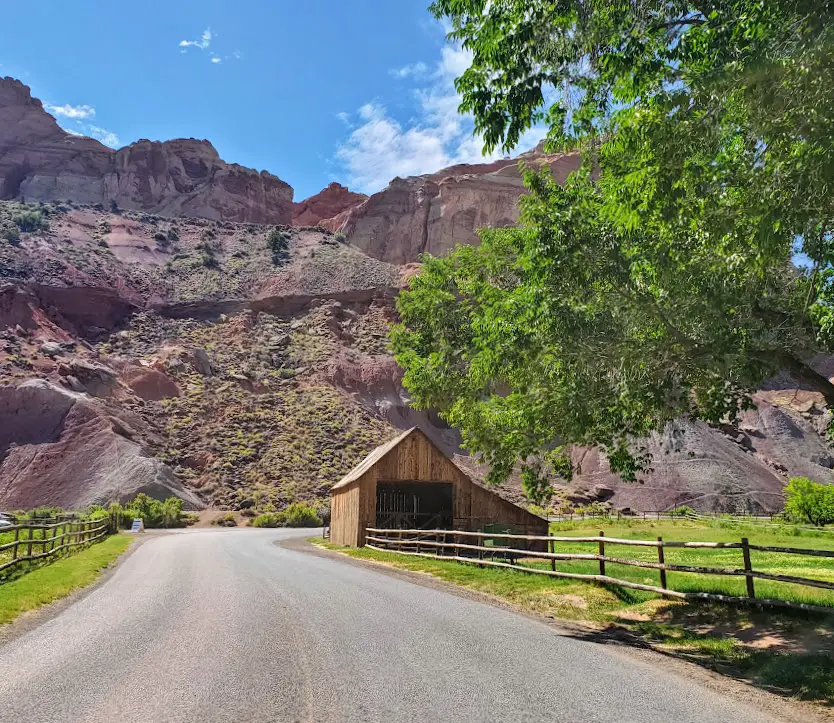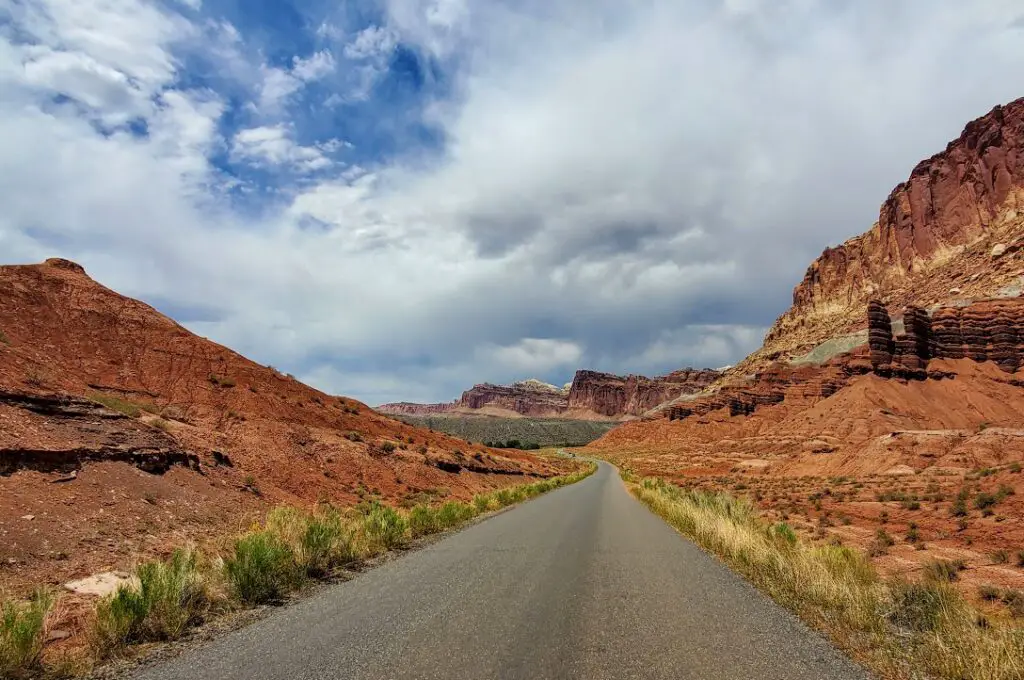
Getting to Capitol Reef
Capitol Reef is located in South-Central Utah, nestled perfectly between Bryce Canyon and Canyonlands National Park. It is part of Utah’s “Mighty 5” alongside Zion, Bryce, Canyonlands, and Arches. The closest town is Torrey, but it isn’t very big. The bigger town of Boulder, UT is 45 miles away.
The closest airport to Capitol Reef is Grand Junction Regional Airport in Colorado (196 miles). If Capitol Reef is part of a bigger trip, I recommend flying into either Vegas or Salt Lake City to see Zion and Bryce (or all 5 parks!).
Fees & Cancellation Stamp
Entrance into the park is free; however, it will cost to drive or walk on the scenic drive. Payment is done by way of the “honor system” and you put your money in an envelope and then into a drop box. If you have the America the Beautiful pass I suggest displaying it in your windshield.
$10 for pedestrians (either on foot or bicycle)
$20 for private vehicles
$15 for motorcycles
The cancellation stamp can be found at the visitor center at the front of the park.
Time Required in Capitol Reef
You can see the main parts of Capitol Reef in one day. I would add a day for every major hike you want to do, or if you’d like to do the 124 mile scenic drive. If you want to see all the main parts and do 2-3 small hikes, 2 nights/3 days would be sufficient.
I had one full day in Capitol Reef and had time to do one hike (Hickman Bridge), see all of the Fruita area, and do the Scenic Drive. I had planned a 2nd hike I would have had time for but it was just so hot I didn’t do it. Eventually, I would like to go back and spend a few days exploring the Waterpocket District and doing more hikes.
Camping in Capitol Reef
Fruita is the main campground in the park. It has 71 sites, all non-electric (no hookups), but there is potable water and a dump station. The restrooms have running water and flush toilets but there are no showers. All sites are $25 per night, reservation only from March 1 – October 31st. In the off season they are all first come first serve.
There is one group campsite near Fruita. Click here for all the rules and regulations regarding this site.
There are two additional primitive campgrounds: Cathedral Valley and Cedar Mesa. Both are free on a first come first serve basis, but are not easily accessible and have no running water.
Lodging Outside of Capitol Reef
The only “lodging” option inside the park is to camp. Therefore, if you’d like a comfortable bed and air conditioning, you’ll have to stay in the town of Torrey, which is only a short 15 minute drive. Of course there are other options further out, it just depends how far you are willing to drive.
Things to do in Capitol Reef
Fruita Historic District

Most of the things to “see” in Capitol Reef are in the Fruita Historic District, as it’s considered the heart of the park. Make sure to visit the Gifford Homestead and pick up a fresh baked pie. You can also check out the Fruita Schoolhouse, petroglyph panel, and pick seasonal fruit in their many orchards. The Fremont River runs through this area and is a nice place to cool off in if you are visiting during the hot summer months.
Fruita District Orchards
Back in the 1880’s, Latter-Day Saints pioneers planted thousands of fruit trees as a source of food and income. Currently, the orchards are preserved and protected through the National Register of Historic Places. You can pick fruit throughout the year wherever you see “U-pick” signs. There is s self-pay station with a scale and prices at the entrance of the orchards.
Waterpocket District (South)
The Waterpocket District is a remote and rugged section located in the Southern part of the park. It is highly recommended that you check the weather forecast before driving on the roads because rain storms can wash the roads out.
Many people who visit the Southern section choose to do the Loop-The-Fold driving tour. It is 124 miles and takes 4-6 hours depending how much you stop, but you can just do sections of it if you wish. The geology of the park changes the further South you go and Loop-The-Fold is a great way to see that. Oyster Shell Reef and Strike Valley are good sections to visit in the Waterpocket District.
Cathedral Valley District (North)
The Cathedral Valley District is very remote and rugged. If you plan to do the entire loop, you must cross over the Fremont River because there is no bridge. A high clearance vehicle is required. There is little to no cell phone reception and the NPS website suggests carrying extra gas, clothes, water food, and even a shovel for emergency situations (I’m assuming to dig your car out). The Cathedral Valley Driving Loop Tour is in this section. It is almost 58 miles long and takes 6-8 hours to complete depending on how often you stop. Bentonite Hills, South Desert, Glass Mountain, and Gypsum Sinkhole are popular sections of this district.
Scenic Drive

If the two driving loop tours in the North and South District seem intimidating, or you just simply don’t have that much time, consider the Scenic Drive in the Fruita District. It is 7.9 miles long and only takes around 90 minutes to complete. It is an out-and-back road so you could actually turn around whenever you want. This drive does cost $20 by way of the honor system; however, I do believe the America the Beautiful pass covers this fee.
Hiking in Capitol Reef
I only completed one hike on my day trip to Capitol Reef. I had planned to do two, but due to the heat I chose not to do the second one. Please keep the heat in mind if you are traveling to the park in the summer months. I will review my hike and list a few other popular options.
Hickman Bridge

Distance: 1.8 miles
Elevation Gain: 416 feet
Review: This hike is not hard and very family friendly; however, almost all of it is out the sun with little to no shade. I started this hike around 1pm and it was HOT (middle of June). Please start any hike in CRNP early in the morning if going in the summer months.
Check out the NPS site for a complete list of day hikes, but here are the ones I considered doing:
- Capitol Gorge (2 miles, easy)
- Cassidy Arch (3.4 miles, strenuous)
- Sunset Point (.8 miles, easy)
Know before you go
In all of my research and travels, this park, more than others, seems to be one you really need to pay attention to the weather. It gets very hot and very cold in Capitol Reef. They are also prone to flash-floods like in Zion. Always have a good idea what the day will look like and speak to the rangers to confirm if you will be in remote areas.
There aren’t many food options in the park. Gifford’s sells pies and things like jams and honey, but not food that would amount to a substantial meal. Plan accordingly by packing your food!
I would LOVE to spend more time in this park, especially in the Waterpocket District. However, in the full day that I had, I felt like I saw and experienced the park enough for it to count. I still need to visit Arches and Canyonlands, and plan to get back to Capitol Reef on that trip.
Last Updated: December 29, 2022
Leave a Reply